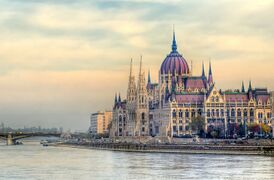Grajnidar: Difference between revisions
mNo edit summary |
|||
| Line 94: | Line 94: | ||
</gallery> | </gallery> | ||
==Society== | |||
==Culture== | ===Sports=== | ||
Grajnidarens are amongst the world elite in boxxing, as the sport belongs to the most popular one sin the whole country. | |||
===Culture=== | |||
The Grajdinaren culture is made up from 2 relatively different cultures - the Gralju-Jniten and the Vsikite. The Gralju-Jniten is the culture of the Graljus and Jnitens and is the thing people usually mean by 'Grajdinaren culture'. The Vsikite meanwhile often being forgotten and looked over, as it the culture of Vsikites, a minority group in the country living exclusively in the northern parts. These 2 cultures are of course not that different, as Vsikites are part of the same ethno-linguistic group as the rest of the populace, but the centuries of foreign influence and distancing from the rest of the country have surely had some effects. | The Grajdinaren culture is made up from 2 relatively different cultures - the Gralju-Jniten and the Vsikite. The Gralju-Jniten is the culture of the Graljus and Jnitens and is the thing people usually mean by 'Grajdinaren culture'. The Vsikite meanwhile often being forgotten and looked over, as it the culture of Vsikites, a minority group in the country living exclusively in the northern parts. These 2 cultures are of course not that different, as Vsikites are part of the same ethno-linguistic group as the rest of the populace, but the centuries of foreign influence and distancing from the rest of the country have surely had some effects. | ||
The Gralju-Jniten culture is a very rich culture with almost no foreign influence at all. Till this very day most of the traditions are still alive, mostly in the nation's country-side. | The Gralju-Jniten culture is a very rich culture with almost no foreign influence at all. Till this very day most of the traditions are still alive, mostly in the nation's country-side. | ||
The Vsikite culture, while being Ganatic, was heavily influenced by romance cultures, most notably the French from the neighboring Aciria. | The Vsikite culture, while being Ganatic, was heavily influenced by romance cultures, most notably the French from the neighboring Aciria. | ||
=== Religion=== | === Religion=== | ||
Grajnidar is a very religious nation. The official and pretty much dominant (88% of the populace) religion is Varheism, which worships the two god siblings - Varskstullu and Varmaakon, sometimes called simply the day and the night. The whole religion comes from the holy texts called 'Rataksi Varheistv' written by prophet Kaarlin, who returned from the Danoc, another world hidden between day and night where every soul goes after death. | Grajnidar is a very religious nation. The official and pretty much dominant (88% of the populace) religion is Varheism, which worships the two god siblings - Varskstullu and Varmaakon, sometimes called simply the day and the night. The whole religion comes from the holy texts called 'Rataksi Varheistv' written by prophet Kaarlin, who returned from the Danoc, another world hidden between day and night where every soul goes after death. | ||
==Military== | ==Military== | ||
The military in Grajnidar is split into 2 parts working independently from eachother. The Grajnidaren National Armed Forces and the Grajnidaren Royal Guards. While the Grajnidaren National Armed Forces (GNAF for short) are made of Land, Naval and Air Forces which serve the nation and are the thing people usually mean by 'Grajnidaren military', the Grajnidaren Royal Guards (GRG for short) are made of various elite forces which serve and protect the royal family, the most well-known elite force being the royal guards, from which the whole group is named after. It is said that these 2 groups can, if it is for some reason needed, attack eachother, but it will most likely never happen. | The military in Grajnidar is split into 2 parts working independently from eachother. The Grajnidaren National Armed Forces and the Grajnidaren Royal Guards. While the Grajnidaren National Armed Forces (GNAF for short) are made of Land, Naval and Air Forces which serve the nation and are the thing people usually mean by 'Grajnidaren military', the Grajnidaren Royal Guards (GRG for short) are made of various elite forces which serve and protect the royal family, the most well-known elite force being the royal guards, from which the whole group is named after. It is said that these 2 groups can, if it is for some reason needed, attack eachother, but it will most likely never happen. | ||
=== Grajnidaren National Armed Forces === | === Grajnidaren National Armed Forces === | ||
The Grajnidaren National Armed Forces are made of Grajnidaren Land Forces, Grajnidaren Naval Forces and Grajnidaren Air Forces. It is currently lead by the Chief of the General Staff Miko Akwara. Historically the GNAF has always been a fairly advanced and powerful, although not used too often. In modern day it is mosly specialised at AI, with the Grajnidaren attack drones being one of the best in the world. | The Grajnidaren National Armed Forces are made of Grajnidaren Land Forces, Grajnidaren Naval Forces and Grajnidaren Air Forces. It is currently lead by the Chief of the General Staff Miko Akwara. Historically the GNAF has always been a fairly advanced and powerful, although not used too often. In modern day it is mosly specialised at AI, with the Grajnidaren attack drones being one of the best in the world. | ||
Revision as of 17:57, 7 March 2022
This article is a work-in-progress because it is incomplete and pending further input from an author. Note: The contents of this article are not considered canonical and may be inaccurate. Please comment on this article's talk page to share your input, comments and questions. |
Kingdom of Grajnidar Mnijanca Kgrajnitarsko'kmaka (New Grajni) | |
|---|---|
Motto: Pte litun fjense'kmaka ("For the greater good") | |
 Location of Grajnidar (dark green) | |
| Capital | Minvras |
| Largest city | Kralank |
| Official languages | New Grajni |
| Religion | Varheism |
| Demonym(s) | Grajnidaren (noun) Grajnidaren (adjective) |
| Government | Constitutional Monarchy |
| Ukwar II. | |
• Premier | Jondar Nakastee (Grajnidaren Democratic Party) |
| Population | |
• Estimate | 79,932,213 |
| GDP (nominal) | estimate |
• Total | $1,784,646,519,651 |
• Per capita | $22,327 |
| Currency | Grajnidaren Crown |
| Driving side | right |
| Calling code | +280 |
Grajnidar, officially the Kingdom of Grajnidar, is a Constitutional Monarchy located in southern Sarpedon. While the nation shares a maritime border in the Natiserve Bay with the Krasoa Islands, belonging to Kiravia, its only land neighbor is Aciria, which is located to the north of the country. Covering an area of more than 1,2 million km² and hosting a population of nearly 80 million, the nation is made of 3 historical states, now provinces, which are further divided into 25 regions. There's a relatively big disparity between the quality of life of different parts of the country, with the more south-eastern regions usually scoring much higher than the rest of the country in many statistics.
Different people, different culture, located on the edge of the world, Grajnidar was a fairly mysterious place to other nations throughout the history. It is one of the very few nations which have never ever been under any foreign power's rule, mostly thanks to its geographically blessed location and the historical battle abilities of its people. Grajnidar usually played the third side in many international conflicts, simply aiming for nothing more than to profit. This has turned Grajnidarens into somewhat not-trustworthy in the eyes of other nationalities.
The city of Minvras, while being the national capital, is not the largest or even the most populated city in the country. This imaginary throne belongs to Kralank, an enormous mountainous metropolis in the eastern part of the country.
Name
Historically, before the Kingdom of Grajnidar, the nation was called the Grajni Realm. 'Grajni' being a mix of the names of the 2 ethnic groups of the Realm, Gralju and Jniten. 'Dar' means 'land' in New Grajni and other south Ganatic languages, and it was added to the name in 1919 simply to differ the newly created Kingdom from its predecessor.
The etymology of Gralju and Jniten is unknown.
History
(work in progress)
Great Grajnidaren Raids
The first ever mentions of the Ganatic tribes come from the 6th century, when they entered the continent of Sarpedon as 3 groups of raider tribes - Gralju, Jniten and Vsikit. While these groups were independed from eachother, they cooperated in their raiding efforts and in just 4 years managed to succesfully murder, or simply kick out, all the original inhabitants of roughtly the area that makes today's Grajnidar. When the tribe groups slowly transitioned into tribe federations, giving the leaders more power and allowing easier organisation, these 3 entities cooperated once more and started what is called the Great Grajnidaren Raids. These raids were very successful, as the Grajnidarens had, at the time, fairly advanced gear and weapons and were well-known for their battle abilities. The semi-nomadic federations conquered many areas both in the east, where they were fairly dominant throughout the whole history, but also in the north, mostly in what makes today's Aciria. For some time it really looked like nothing can ever stop them, but then they've met the powers of northern Sarpedon, which quickly put an end to their campaign to the north. After this and many other failures, the federations decided to return and settle to the lands they originally conquered, the Grajnidaren lands...
First Grajni Realm
About 2 centuries after the federations settled in the Grajnidaren lands, the cooperation between Gralju and Jnited reached next level. In the early 10th century the 2 federations merged together and created the first centralised Grajnidaren state - the First Grajni Realm. The emperor of this newly created realm Jahanii, later known as Jahanii the Great, was a wise man. He, with his decisions, really united the people and, eventhought the Realm was made of 2 different cultures, created the foundations of the Grajnidaren national identity. The Realm was not very expansionist under him, as he mostly focused on developing the lands already controlled by it. The same cannot be said about his successor, Milnio. When he took over the Realm after his father's death, he didn't waste any time and immediately started to take actions in order to expand the nation. He, with his strong nationalistic Gralju feel, viewed Jnitens as less valued members of the society and often practised discrimination. Under his reign, Jnitens were kicked out of the ruling elite for simply being Jnitens and after no more than a decade the Realm was exclusively ran by Graljus. Jnitens were of course not happy with these actions and tried to get a man of their own on the throne after Milnio's death. These efforts failed. Till the start of the Acirian War in the 12th century, the Realm was ruled by exclusively Graljus, but the discrimination of Milnio's reign got significantly better over time.
Acirian War
In XXXX, the Vsikitan Commonwealth, at the time still independend from the Realm, got attacked by a nationalist militant group from the neighboring Aciria. This started a very long and complicated conflict which resulted in the Vsikitan Commonwealth joining the newly created second Grajni Realm.
Second Grajni Realm
Age Of Chaos
The Kingdom of Grajnidar
Goverment

Grajnidar is a fairly authoritarian parliamentary constitutional monarchy. On paper the nation is lead by the Premier Jondar Nakastee from the Grajnidaren Democratic Party (GDP), who serves as the only head of goverment. With the king Ukwar II. from the Muulikartheda dynasty being nothing more than the head of state. But in reality the King has much more power over the goverment. He can decide what laws and changes will pass, and which not. He has control over the whole Grajnidaren diplomacy and often gives 'little tips' to the goverment, which, althought do not officially have to be, are always fully implemented. The Grajnidaren constitution has seen quite a few changes in the past years, slowly giving the King more and more power. And while these changes and the goal of them is quite obvious, no one was ever successful in the efforts of stopping it from happening.
The National Parliament is responsible for drafting new laws and handling the state budget, but alone doesn't really have any power, as before a law passes it needs to be checked by the Senate and then the King who has the ability to dismiss anything he doesn't particularly like, which he uses quite often.
The National Senate is responsible for overseeing the Parliament and maintaining democracy by making sure nothing violates the constitution. The Senate is supposed to be completely independend, but is currently made out of exclusively royal-associated senators. That is the cause of the recent changes and bending of the constitution in favor of the monarchs.
Grajnidaren politics have overall a relatively big problem with corruption and bribery.
Geography
Grajnidar has a temperate climate, situated in the oceanic climate type, with mild summers and cool but not cold winters. It is one of the southernmost nations in the world, residing in the south-western Sarpedon.
-
Countryside in the Jniten regions
-
The Royal Palace in Minvras
-
The Djenika Mountains located in the eastern part of the country
Society
Sports
Grajnidarens are amongst the world elite in boxxing, as the sport belongs to the most popular one sin the whole country.
Culture
The Grajdinaren culture is made up from 2 relatively different cultures - the Gralju-Jniten and the Vsikite. The Gralju-Jniten is the culture of the Graljus and Jnitens and is the thing people usually mean by 'Grajdinaren culture'. The Vsikite meanwhile often being forgotten and looked over, as it the culture of Vsikites, a minority group in the country living exclusively in the northern parts. These 2 cultures are of course not that different, as Vsikites are part of the same ethno-linguistic group as the rest of the populace, but the centuries of foreign influence and distancing from the rest of the country have surely had some effects.
The Gralju-Jniten culture is a very rich culture with almost no foreign influence at all. Till this very day most of the traditions are still alive, mostly in the nation's country-side.
The Vsikite culture, while being Ganatic, was heavily influenced by romance cultures, most notably the French from the neighboring Aciria.
Religion
Grajnidar is a very religious nation. The official and pretty much dominant (88% of the populace) religion is Varheism, which worships the two god siblings - Varskstullu and Varmaakon, sometimes called simply the day and the night. The whole religion comes from the holy texts called 'Rataksi Varheistv' written by prophet Kaarlin, who returned from the Danoc, another world hidden between day and night where every soul goes after death.
Military
The military in Grajnidar is split into 2 parts working independently from eachother. The Grajnidaren National Armed Forces and the Grajnidaren Royal Guards. While the Grajnidaren National Armed Forces (GNAF for short) are made of Land, Naval and Air Forces which serve the nation and are the thing people usually mean by 'Grajnidaren military', the Grajnidaren Royal Guards (GRG for short) are made of various elite forces which serve and protect the royal family, the most well-known elite force being the royal guards, from which the whole group is named after. It is said that these 2 groups can, if it is for some reason needed, attack eachother, but it will most likely never happen.
Grajnidaren National Armed Forces
The Grajnidaren National Armed Forces are made of Grajnidaren Land Forces, Grajnidaren Naval Forces and Grajnidaren Air Forces. It is currently lead by the Chief of the General Staff Miko Akwara. Historically the GNAF has always been a fairly advanced and powerful, although not used too often. In modern day it is mosly specialised at AI, with the Grajnidaren attack drones being one of the best in the world.




